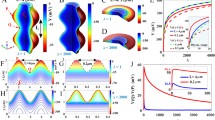Abstract
There has been much interest in the biochemical and biophysical processes that couple extracellular signals to alterations in gene expression. While many early events associated with the treatment of cells with growth factors have been described (for example, ion flux and protein phosphorylation1,2), it has proved difficult to establish biochemical links to gene expression. Recently, the study of such genomic control signals has been facilitated by the demonstration that the c-fos proto-oncogene is rapidly and transiently induced by treatment of several cell types with polypeptide growth factors and other growth modulating substances3–8. In one particular system it has been shown that nerve growth factor (NGF) causes a transient induction of c-fos in the phaeo-chromocytoma cell line PC12, within 15 min9–11. Furthermore, the magnitude of this induction can be modulated with pharmacological agents such as peripheral-type benzodiazepines (BZDs)9. Thus, the study of c-fos expression in PC12 cells could yield valuable clues to the coupling mechanisms linking cell surface activation to genomic events. Here we demonstrate that c-fos is induced in PC12 cells either by receptor–ligand interaction or by agents or conditions that effect voltage-dependent calcium channels.
Similar content being viewed by others
References
Halegoua, S. & Patrick, J. Cell 22, 571–581 (1980).
Rozengurt, E. & Heppel, G. A. Proc. natn. Acad. Sci. U.S.A. 72, 4492–4495 (1975).
Greenberg, M. E. & Ziff, E. B. Nature 311, 433–438 (1984).
Cochran, B. H. et al. Science 226, 1080–1082 (1984).
Kruijer, W. et al. Nature 312, 711–716 (1984).
Muller, R. et al. Nature 312, 716–720 (1984).
Bravo, R. et al. EMBO J. 4, 1193–1197 (1985).
Muller, R. et al. Nature 314, 546–548 (1985).
Curran, T. & Morgan, J. I. Science 229, 1265–1268 (1985).
Kruijer, W., Schubert, D. & Verma, I. M. Proc. natn. Acad. Sci. U.S.A. 82, 7330–7334 (1985).
Greenberg, M. E., Green, L. A. & Ziff, E. B. J. biol. Chem. 260, 14101–14110 (1985).
Schubert, D. et al. Nature 273, 718–723 (1978).
Traynor, A. & Schubert, D. Devl Brain Res. 14, 197–203 (1984).
Kazda, S. et al. Arzneimittel Forsch. 30, 2144–2162 (1980).
Toll, L. J. biol. Chem. 257, 13189–13192 (1982).
Prozialeck, W. C. & Weiss, B. J. Pharmac. exp. Ther. 222, 509–516 (1982).
Nishizuka, Y. Nature 308, 693–697 (1984).
Schatzman, R. C., Wise, B. C. & Kuo, J. F. Biochem. biophys. Res. Commun. 98, 669–676 (1981).
Hidaka, H. & Tanaka, T. Meth. Enzym. 102, 185–194 (1983).
Shanes, A. M. Pharmac. Rev. 10, 59–274 (1958).
Narahashi, T. Physiol. Rev. 54, 813–889 (1974).
Narahashi, T., Moore, J. W. & Scott, W. R. J. gen. Physiol. 47, 965–974 (1964).
Dichter, M. A., Tischler, A. S. & Greene, L. A. Nature 268, 501–504 (1977).
Schramm, M. et al. Nature 303, 535–537 (1983).
Greenberg, D. A., Carpenter, C. L. & Cooper, E. C. J. Neurochem. 45, 990–993 (1985).
Nowycky, M. C., Fox, A. P. & Tsien, R. W. Proc. natn. Acad. Sci. U.S.A. 82, 2178–2182 (1985).
Treisman, R. Cell 42, 889–902 (1985).
Bazett-Jones, D. P., Yeckel, M. & Gottesfeld, J. M. Nature 317, 824–828 (1985).
White, B. A. J. biol. Chem. 260, 1213–1217 (1985).
Hann, S. R., Thompson, C. B. & Eisenman, R. E. Nature 314, 366–369 (1985).
Thompson, C. B. et al. Nature 314, 363–366 (1985).
Muller, R. & Wagner, E. F. Nature 311, 438–442 (1984).
Greene, L. A. & Tischler, A. S. Proc. natn. Acad. Sci. U.S.A. 73, 2424–2428 (1976).
Curran, T. et al. Molec. cell Biol. 5, 167–172 (1985).
Laemmli, U. K. Nature 227, 680–685 (1970).
Author information
Authors and Affiliations
Rights and permissions
About this article
Cite this article
Morgan, J., Curran, T. Role of ion flux in the control of c-fos expression. Nature 322, 552–555 (1986). https://doi.org/10.1038/322552a0
Received:
Accepted:
Issue Date:
DOI: https://doi.org/10.1038/322552a0
- Springer Nature Limited
This article is cited by
-
Excitation–transcription coupling, neuronal gene expression and synaptic plasticity
Nature Reviews Neuroscience (2023)
-
Fos ensembles encode and shape stable spatial maps in the hippocampus
Nature (2022)
-
Protein Kinase C-Gamma Knockout Mice Show Impaired Hippocampal Short-Term Memory While Preserved Long-Term Memory
Molecular Neurobiology (2021)
-
Disruption of Cav1.2-mediated signaling is a pathway for ketamine-induced pathology
Nature Communications (2020)
-
Lineage divergence of activity-driven transcription and evolution of cognitive ability
Nature Reviews Neuroscience (2018)





